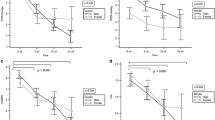Abstract
Introduction and hypothesis
The aim of this study was to evaluate for any association between pretreatment cystometry results and outcome of treatment with mirabegron in women with overactive bladder (OAB) symptoms.
Methods
This was a prospective observational study of women with OAB symptoms that proved refractory to conservative management. All women underwent filling and voiding subtraction cystometry prior to further treatment. Women were treated with mirabegron 50 mg once daily, and outcomes were evaluated after 6 weeks’ treatment. The primary outcome measure was change in symptoms as indicated by response to the Patient Global Impression of Improvement (PGI-I) scale. The presence of detrusor overactivity (DO), the highest detrusor pressure recorded during the filling phase, the presence of urodynamic stress incontinence (USI), cystometric capacity, voided volume, maximum flow rate and detrusor pressure at maximum flow were all compared between responders and nonresponders.
Results
The study population consisted of 169 women; response rate to mirabegron was 69.8 %. There was no association between the presence of DO or maximum detrusor pressure during filling and USI, cystometric capacity, maximum flow rate and detrusor pressure at maximum flow and treatment response. In a subgroup with OAB symptoms refractory to previous treatment with antimuscarinics, there was an association between the presence of DO and a positive treatment response (p = 0.02).
Conclusions
Overall, there is no association between urodynamic findings and response to treatment with mirabegron. This may reflect the fact that mirabegron’s mode of action mechanisms are not measurable using cystometry. In women with refractory symptoms, however, the presence of DO is associated with a positive response to treatment.

Similar content being viewed by others
References
Wuest M, Eichhorn B, Grimm M, Wirth M, Ravens U, Kaumann A (2009) Catecholamines relax detrusor through beta-2 adrenoreceptors in mouse and beta-3 adrenoreceptors in man. J Pharmacol Exp Ther 328:213–222
Michel M, Cernecka H, Ochodnicky P (2011) Desirable properties of β3-adrenoreceptor agonists: implications for the selection of drug development candidates. Eur J Pharmacol 657:1–3
Takasu T, Ukai M, Sato S, Matsui T, Nagase I, Maruyama T, Sasamata M, Miyata K, Uchida H, Yamaguchi O (2007) Effect of ( R )-2-(2-aminothiazol-4-yl)-4’-{2-[(2-hydroxy-2-phenylethyl)amino]ethyl}acetanilide (YM178), a novel selective beta-3-adrenoreceptor agonist, on bladder function. J Pharmacol Exp Ther 321:642–647
Kanie S, Otsuka A, Yoshikawa S, Morimoto T, Hareyama N, Okazaki S, Kobayashi R, Hasebe K, Nakao K, Hayashi R, Mochizuki H, Matsumoto R, Ozono S (2012) Pharmacological effect of TRK-380, a novel selective human β3-adrenoceptor agonist, on mammalian detrusor strips. Urology 79:744.e1-7
Chapple C, Khullar V, Nitti VW et al (2015) Efficacy of the β3-adrenoceptor Agonist Mirabegron for the Treatment of Overactive Bladder by Severity of Incontinence at Baseline: A Post Hoc Analysis of Pooled Data from Three Randomised Phase 3 Trials. Eur Urol 67:11–14
Kuo HC, Lee KS, Na Y, Sood R, Nakaji S, Kubota Y, Kuroishi K (2014) Results of a randomized, double-blind, parallel-group, placebo- and active-controlled, multicenter study of mirabegron, a β3-adrenoceptor agonist, in patients with overactive bladder in Asia. Neurourol Urodyn. doi:10.1002/nau.22645
Abrams P, Kelleher C, Staskin D et al (2015) Combination Treatment with Mirabegron and Solifenacin in Patients with Overactive Bladder: Efficacy and Safety Results from a Randomised, Double-blind, Dose-ranging, Phase 2 Study (Symphony). Eur Urol 67:577–588
Malone-Lee J, Henshaw D, Cummings K (2003) Urodynamic verification of an overactive bladder is not a prerequisite for antimuscarinic treatment response. BJU Int 92:415–417
Malone-Lee J, Al-Buheissi S (2009) Does urodynamic verification of overactive bladder determine treatment success? Results from a randomized placebo-controlled study. BJU Int 103:931–937
Nitti V, Rovner E, Bavendam T (2010) Response to fesoterodine in patients with an overactive bladder and urgency urinary incontinence is independent of the finding of detrusor overactivity. BJU Int 105:1268–1275
Svalø J, Nordling J, Bouchelouche K, Andersson KE, Korstanje C, Bouchelouche P (2013) The novel β3-adrenoceptor agonist mirabegron reduces carbachol-induced contractile activity in detrusor tissue from patients with bladder outflow obstruction with or without detrusor overactivity. Eur J Pharmacol 699:101–105
Aizawa N, Igawa Y, Nishizawa O, Wyndaele JJ (2010) Effects of CL316,243, a beta-3-adrenoceptor agonist, and intravesical prostaglandin E2 on the primary bladder afferent activity of the rat. Neurourol Urodyn 29:771–776
Aizawa N, Homma Y, Igawa Y (2012) Effects of mirabegron, a novel β3-adrenoceptor agonist, on primary bladder afferent activity and bladder microcontractions in rats compared with the effects of oxybutynin. Eur Urol 62:1165–1173
Birder L, Nealen M, Kiss S et al (2002) Beta-adrenoreceptor agonists stimulate endothelial nitric oxide synthase in rat urinary bladder urothelial cells. J Neurosci 22:8063–8070
Kanai A, Wyndaele J, Andersson K et al (2011) Researching bladder afferents- determining the effects of (3) adrenergic receptor agonists and botulinum toxin type-A. Neurourol Urodyn 30(5):684–691
Andersson KE, Yoshida M (2003) Antimuscarinics and the overactive detrusor--which is the main mechanism of action? Eur Urol 43:1–5
Aizawa N, Igawa Y, Nishizawa O, Wyndaele J (2010) Effects of CL316,243, a beta-3-adrenoreceptor agonist, and intravesical prostaglandin E2 on the primary bladder afferent activity of the rat. Neurourol Urodyn 229:771–776
Acknowledgments
The authors thank Laura Gooch and Priya Mohankumar, urogynaecology nurse practitioners, for their assistance in collating these data.
Conflicts of interest
Basu has received honoraria and sponsorship for travel from Astellas
Duckett has received honoraria, sponsorship for travel and support for research from Astellas (no input into data collection/analysis/write-up for this study)
Balachandran has no conflicts
Author information
Authors and Affiliations
Corresponding author
Rights and permissions
About this article
Cite this article
Basu, M., Balachandran, A. & Duckett, J. Is pretreatment cystometry important in predicting response to mirabegron in women with overactive bladder symptoms?. Int Urogynecol J 27, 427–431 (2016). https://doi.org/10.1007/s00192-015-2809-3
Received:
Accepted:
Published:
Issue Date:
DOI: https://doi.org/10.1007/s00192-015-2809-3




